Ideas for Bathrooms With Tile Flooring
Bathroom tile flooring is one of the top choices if you want functional, durable, and pleasing-to-the-eye flooring. As bathrooms are high-moisture areas, the right flooring can transform a space into a beautiful, safe, and easy-to-maintain environment. This guide to bathroom flooring ideas illustrates practical insights, real-world applications, and expert tips.
The Importance of Bathroom Tile Flooring.
Therefore, bathroom flooring must have all the above qualities, including water resistance, durability, and style. Because tile can balance these qualities, it’s a popular choice.
- Water Resistance:
Water cannot damage or mould grow on tiles.
- Durability:
Porcelain tiles, with their exceptional durability, can withstand heavy foot traffic without losing their charm, ensuring your investment lasts for decades.
- Design Flexibility:
With a wide range of colours and patterns, bathroom tiles offer unparalleled design flexibility, allowing you to create a space that truly reflects your style and personality.
The Right Bathroom Tile Flooring – What?
You have many options and decisions when selecting the right bathroom tile flooring. You must pick materials that suit your practical needs and personal taste. Green is a family of Mediterranean pottery from the Caesalpiniaceous genus, found between the 1700s and 1800s.
Choosing the right bathroom tile flooring is a crucial decision that can significantly impact the functionality and aesthetics of your space.
1. Porcelain Tiles
Style Tip:
Large porcelain tiles and neutral tones allow for a seamless modern look.
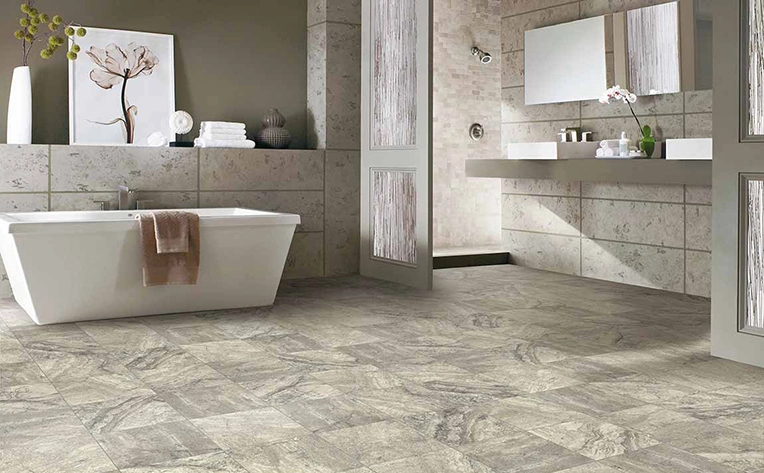
Pros:
- It is very tough and lasting.
- Very resistant to water and stains.
- Matte, Polished, and textured finishes are available.
- For radiant heating systems.
Cons:
- Higher material cost than other materials.
- No heating underfoot cold.
- Its weight and density require professional installation.
2. Ceramic Tiles
Style Tip:
Patterned ceramic tiles are a fun and bold pattern.
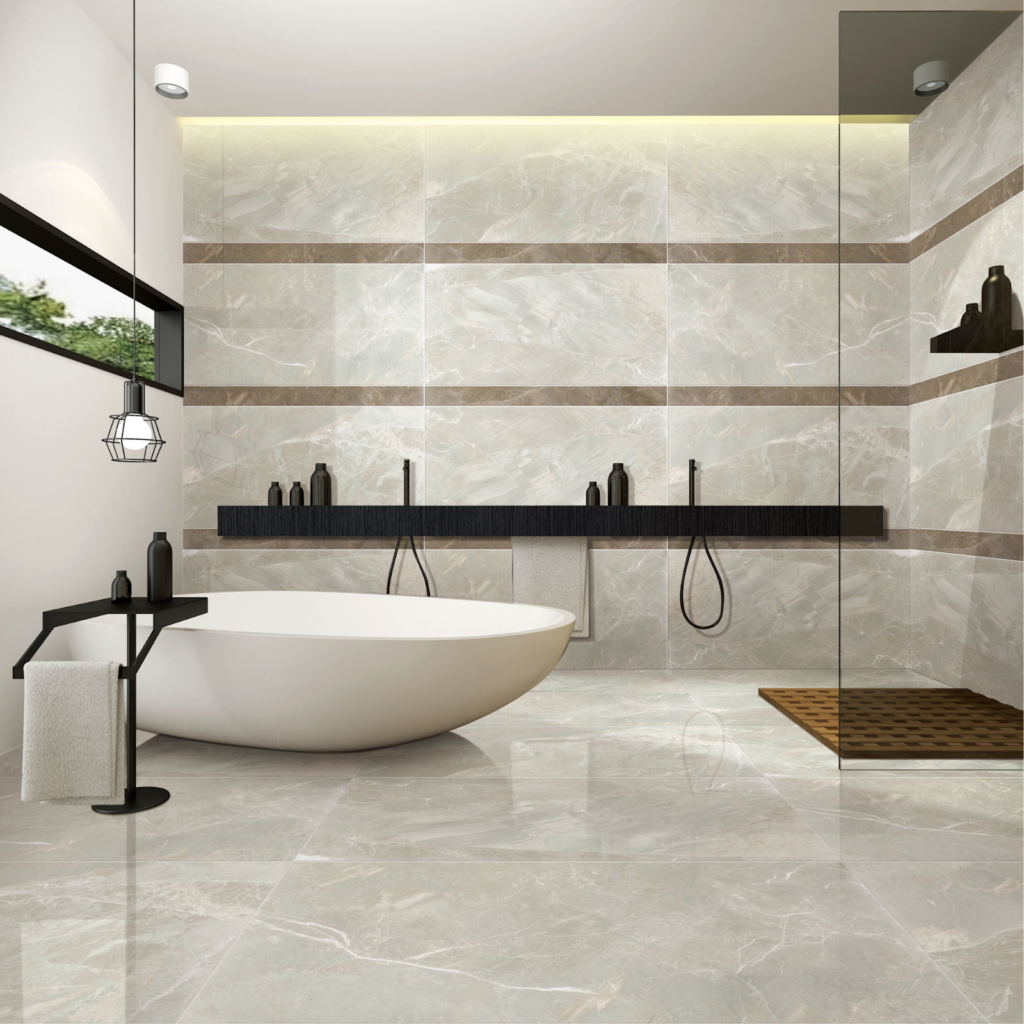
Pros:
- It is affordable and widely available.
- This is made of water-resistant glazed ceramic tiles.
- There are many colours, designs, and finishes available.
- Easy to clean and maintain.
Cons:
- It is less durable than porcelain.
- It can chip or crack under heavy impact.
- Regular cleaning of grout lines may be necessary.
3. Natural Stone Tiles
Style Tip:
Use warm lighting and pair the marble tiles for a luxurious spa-like atmosphere.
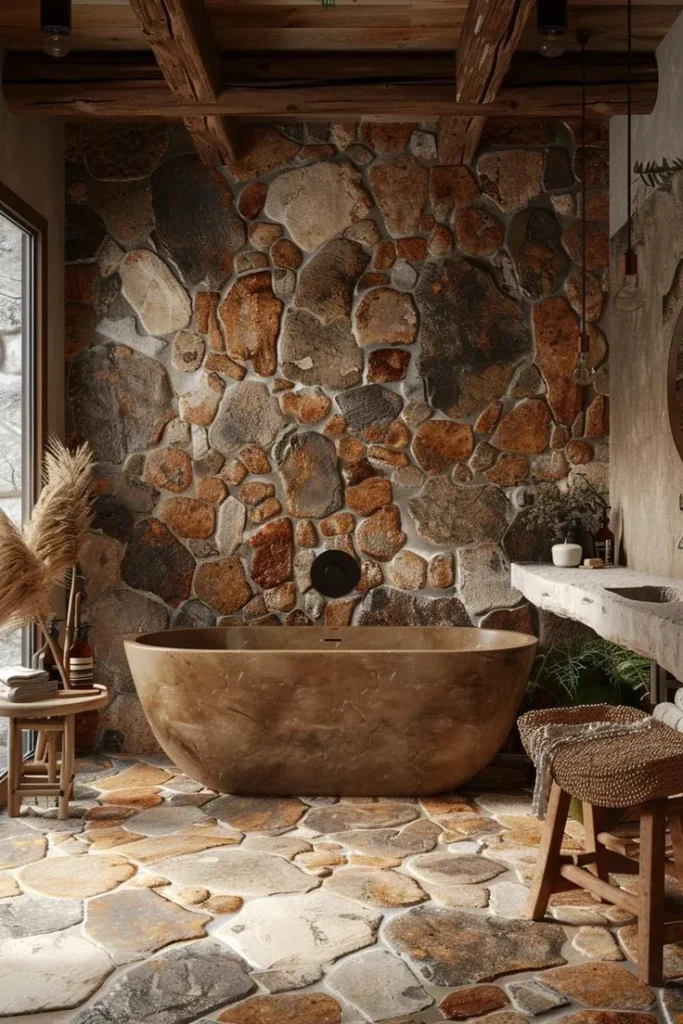
Pros:
- It has a premium feel with unique and natural textures.
- Works with underfloor heating.
- Well-sealed, they are durable and long-lasting.
- It adds significant value to your property.
Cons:
- It needs regular sealing for water resistance.
- Unmarked and slippery when wet unless textured.
- This product is expensive to purchase and install.
4. Vinyl Tiles
Style Tip:
Gone are the days of wood tiles. Now, there is redwood-look wood-look vinyl flooring with a nice natural appearance.
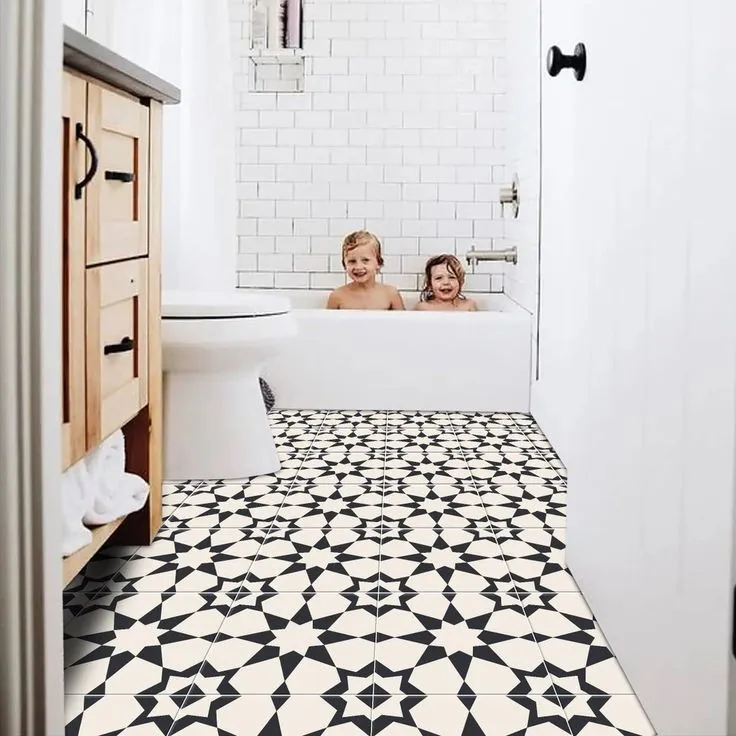
Pros:
- It is 100% waterproof and compatible to keep in high moisture areas.
- Soft and warm underfoot.
- Easy to install, affordable.
- It comes available in several designs, such as wood and stone.
Cons:
- The lower end will probably do without the premium touch.
- If heavy furniture is put on your floor, it can dent.
- Winds up wearing out in high-traffic areas.
5. Mosaic Tiles
Style Tip:
Mosaics make for good shower floors or accent pieces for visual interest.
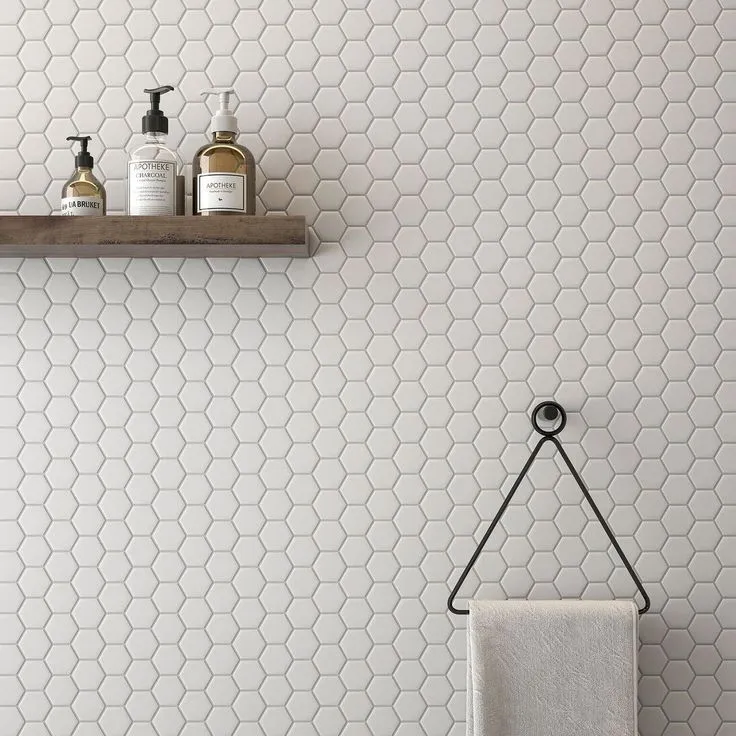
Pros:
- It adds texture and slip resistance.
- Fits on glass, ceramic, or metal finishes.
- Ideal for doing delicate work.
- It works in small or curved spaces.
Cons:
- Labor-intensive installation.
- Grout lines are constantly cleaned.
- Owing to their smaller size than larger tiles, they are more expensive.
6. Glass Tiles
Style Tip:
Glass tiles are an easy way to reflect light into the space and make the room feel brighter, installing them as a backsplash or accent.
Pros:
- It reflects light so that even small bathrooms seem larger.
- Stains and water resistant.
- Sleek and modern aesthetic.
- It offers a variety of colours and finishes.
Cons:
- It can be slippery when wet.
- Scratch prone and prone to chipping.
- It is costly and needs to be professionally installed.
7. Cement Tiles
Style Tip:
Make a bold statement with a floor of bold patterned cement tiles.
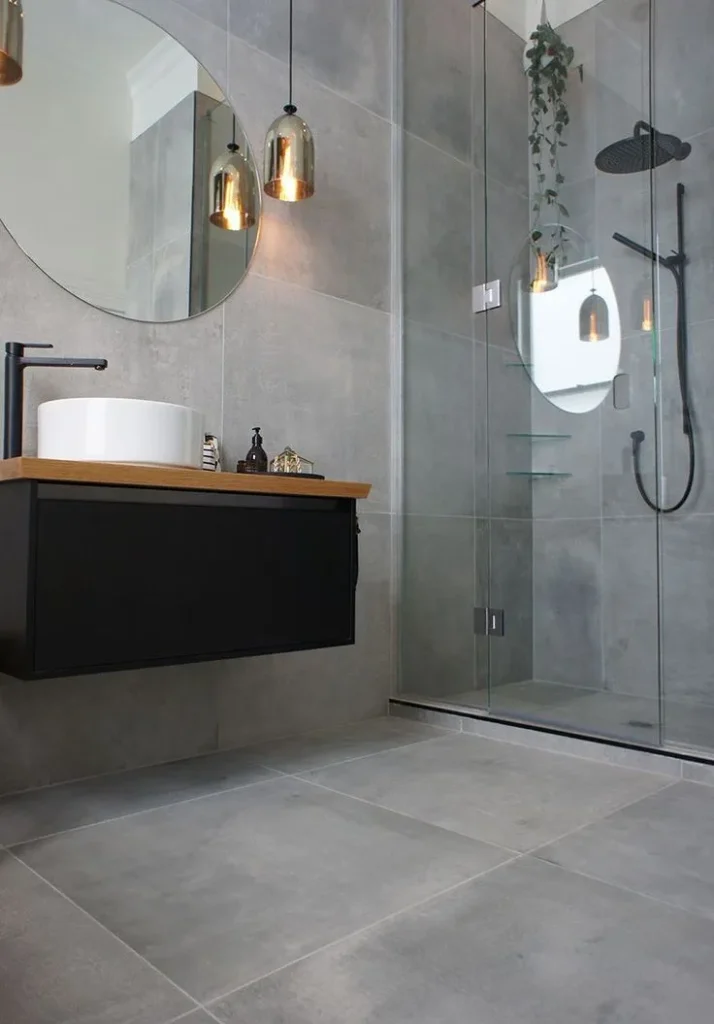
Pros:
- Highly customisable, with vibrant patterns.
- Long-lasting and durable.
- An artistic touch is added to any bathroom.
- Heavy foot traffic resistant.
Cons:
- It needs sealing to prevent water retarding.
- Over time, it can develop a patina.
- Expensive and heavy.
8. Pebble Tiles
Style Tip:
Use pebble tiles on the shower floor to create a natural, spa-like feel.
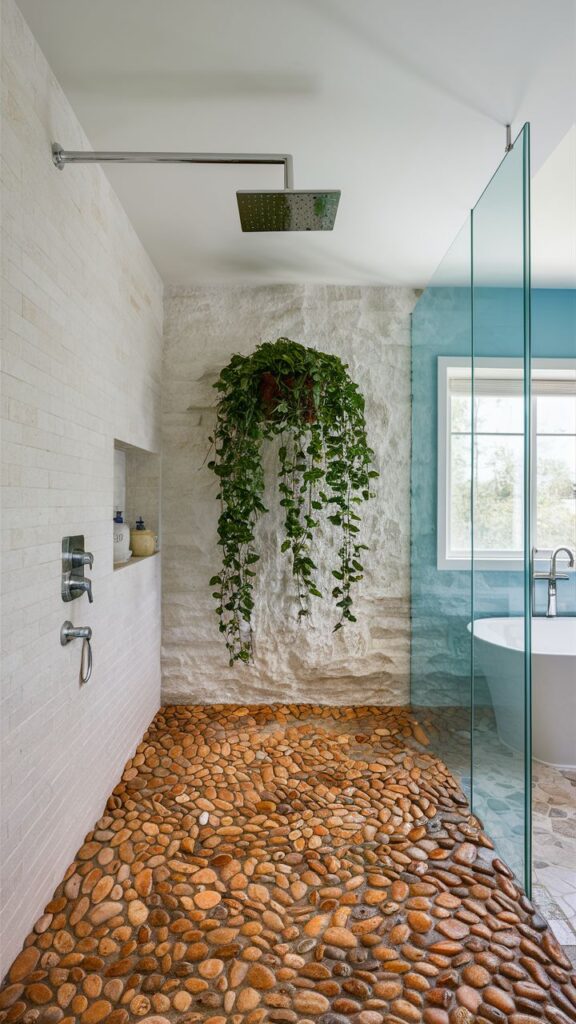
Pros:
- It makes for texture and reduces its slipperiness.
- Durable and long-lasting.
- Appearance of a unique organic shape.
- It works well in wet areas such as showers.
Cons:
- Some may find it uncomfortable on uneven surfaces
- Requires regular sealing.
- Cleaning grout lines can be tricky.
Which Bathroom Tile Flooring Do You Choose?
- Outline Your Goals
- Water resistance is the priority if the bathrooms have high moisture.
- Pick designs that go with your design and home decor.
- Audit Your Bathroom Dimensions
- Small bathrooms look more prominent with large tiles.
- Use mosaics or pebble tiles for curved areas (shower floor) or small areas.
- Set Your Budget
- Budget-friendly options are vinyl and ceramic.
- Porcelain and marble are high-end choices for luxury bathrooms.
Common Design Patterns
- Herringbone Layout
It makes the floor sophisticated and moves with it.
- Grid Patterns
It gives a clean and minimalist look.
- Mosaic Accents
Provides visualised interest in specific areas, such as shower niches.
Real-World Applications
- Slip Resistance
Textured tiles make a walking surface safer in wet conditions because it’s less likely a person will slip.
- Enhancing Small Bathrooms
In expansive effect, coloured tiles with matching grout lines facilitate it.
Additional Applications
- Zoning:
Different tiles can be used to separate dry from wet areas.
- Underfloor Heating:
Radiant heating paired with pair tiles adds to the comfort of the floor.
Tile Flooring Case Studies
Case Study 1: Modern Minimalist Bathroom
- Challenge: Small light space.
- Solution: I installed light-colored porcelain tiles.
- Result: Low maintenance and a spacious design.
Case Study 2: Spa-Like Luxury Bathroom
- Challenge: Water-damaged design.
- Solution: The whole retreat was created using marble tiles and glass mosaics.
Case Study 3: Rustic Bathroom Makeover
- Challenge: Rustic cabin bathroom: worn-out flooring.
- Solution: Textured slate tiles installed.
- Result: I liked its design because it’s earthy, durable, and complements rustic decor.
Tools You Need to Install Tile Affordably
- Tile Cutter: For precise cuts.
- Grout Float: Guarantees a smooth grout application.
- Sealant: Keeps natural stone and grout dry.
FAQs:
- What is the least water-resistant bathroom tile?
The most water-resistant option is porcelain.
- Can you use natural stone in bathrooms?
Yes, it does have to be sealed, but it’s done to prevent water damage.
- How do you deal with bathroom tiles?
- Clean with mild detergents.
- Reseal natural stone tiles once a year.
- Regular broom sweep should be performed to get rid of dirt.
How to Find the Best Tile Flooring
- Read Reviews
Review the durability and aesthetics of tiles by checking reviews.
- Ask for Recommendations
Ask friends, contractors, or trusted suppliers.
- Walk Away from Cheap Offers
You don’t want a lousy option where things like durability and water resistance go out the window.
Conclusion
Ceramic tile flooring continues to be the indisputable choice for bathrooms globally. The market is expected to grow at a CAGR of 6.5% from 2023 to 2028. Recent surveys revealed that 65 per cent of homeowners prefer porcelain tiles because they are durable. They do not break when exposed to water, and another 20 per cent who use vinyl tiles have found them relatively affordable and waterproof.
How do you choose the right tile for your bathroom? First, you must pick a style that suits you. Then, you must priorities different aspects, such as functionality and budget. Large-format tiles make small bathrooms seem large, while textured tiles are necessary for slip resistance in high-moisture areas. Marble and travertine are unmistakably luxury items but add substantial value to homes.
Tile flooring is a durable investment lasting up to 20 – 50 years with proper care and installation. It can be used in many ways to create a beautiful and practical bathroom, whether you’re looking for modern minimalist designs or timeless elegance.

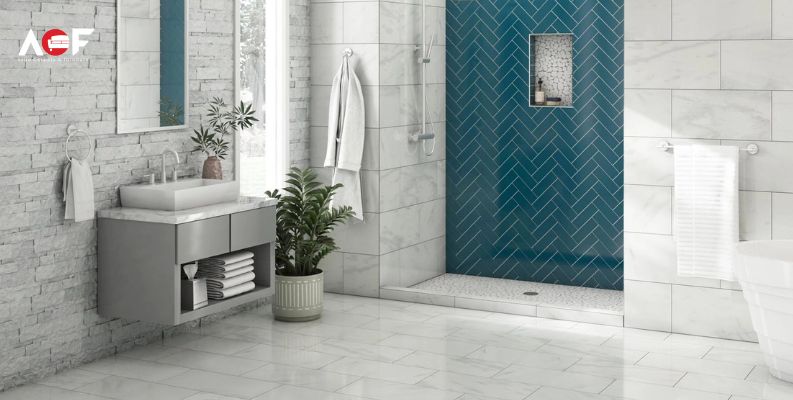
Comments are closed